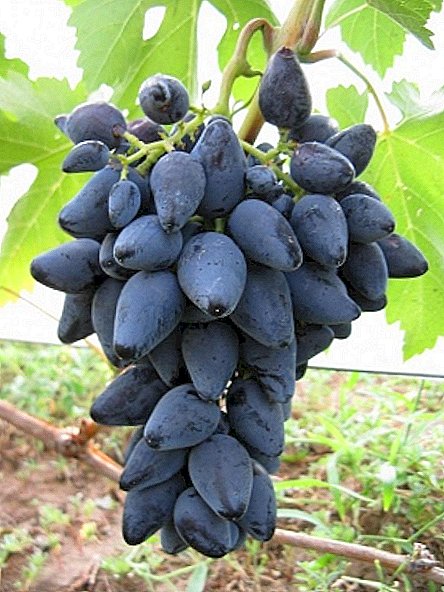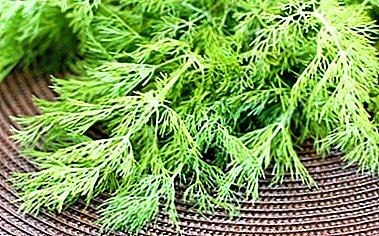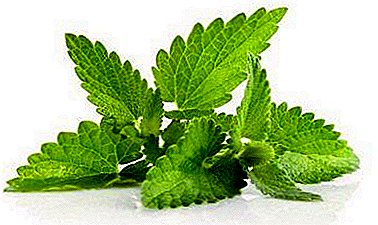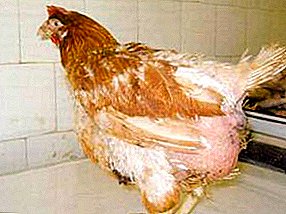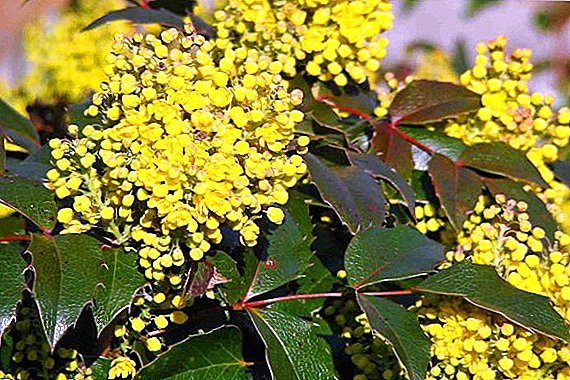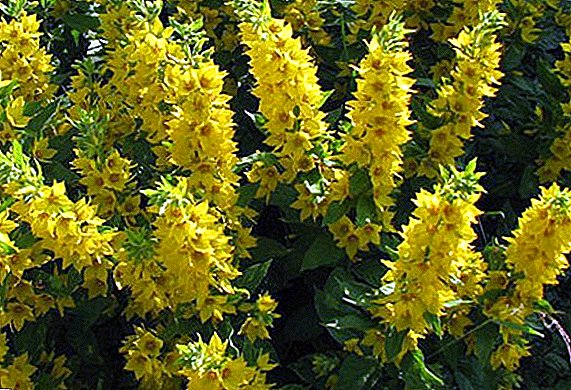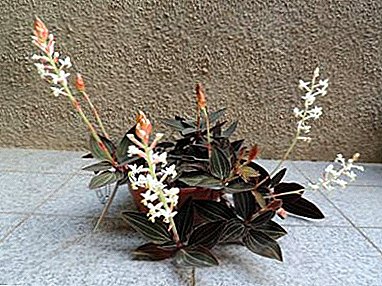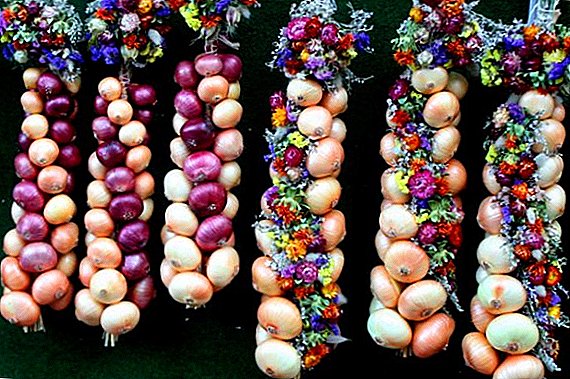 Onions - one of the most popular vegetables. Most people have heard about its benefits and prefer to add it to a variety of dishes. Especially it is useful to use it in the winter and autumn period as a source of vitamins. However, in order for the vegetable to lie a little longer, it is necessary to store it correctly. One of the methods of storage - in braids - will be discussed in our material.
Onions - one of the most popular vegetables. Most people have heard about its benefits and prefer to add it to a variety of dishes. Especially it is useful to use it in the winter and autumn period as a source of vitamins. However, in order for the vegetable to lie a little longer, it is necessary to store it correctly. One of the methods of storage - in braids - will be discussed in our material.
Why should keep onions in braids
In the autumn, after harvesting the onions, each gardener thinks about how and where to save it for a long time, in order to use a tasty and healthy product in the winter and spring. Vegetable can be stored in several ways:

- in wooden or plastic boxes;
- in wicker baskets;
- in bags of dense fabric;
- in cardboard boxes;
- in grids;
- in a suspended state, braided in braids.
Onions are striking with a variety of species - Indian, shallot, sevok, ornamental, leek, batun, chives, onions, slyzun, exibichen, dzhusay, red, multi-tiered, perennial - and each of them can benefit the human body.
The latter method is considered one of the best, since with it every bulb provides sufficient air access, that is, it is well ventilated, which means there are fewer reasons for the development of decay. Also, when interlacing, the bulbs are minimally in contact with each other, therefore they are less deformed.
Another advantage of this storage is that it is convenient to choose vegetables of the right size for dishes, because they are all in sight..

In addition, woven braids of bulbs give an aesthetic look to the room where they are hung, and disinfect the air in it due to the phytoncidal properties of the plant.
The disadvantages of this method include its complexity.
Did you know? People cultivated onions for more than 6 thousand years. Presumably for the first time it began to do in Central, South-West Asia. In ancient Egypt, the vegetable came from the Central Asian territories. In one of the inscriptions found in the pyramid of Cheops, it is mentioned that onions were given to slaves in order to prevent epidemics of diseases. There is an image of this vegetable culture on the tomb of Tutankhamen.
Preparation of onions for weaving
Harvesting is necessary only in dry weather. This process should be carried out after 90-120 days after landing. The exact time of harvesting will depend on the variety you grow. When removing the bulbs from the ground, pulling them and throwing them is contraindicated. This will shorten their laying times.

Onions, which are planned to be saved in braids, should be left with long leaves when harvesting.
Preparing a vegetable for storage involves 3 stages:
- Drying
- Cleaning up
- Sort.

If possible, the drying is carried out in the open air in the shade, spread out horizontally on the nets or hanging in bundles under a canopy. This can also be done in the apartment - on the balcony or on the windowsill, spreading it on paper or on fabric. Suitable for these purposes and the oven.
Another method of drying involves placing the bulbs in the sun for 3 days. During this time, green leaves turn over, and it becomes convenient to weave them. Finally, the onion dries, already being in a spit in limbo. This option of drying is more common when storing onions in braids.
Important! Before you braid the braids, you need to make sure that the sheets are well dried. Otherwise there is a risk of developing cervical rot.
After drying, the onions will need to be peeled. The remains of the soil are removed from it, and the roots are cut to a length of 2 cm.

Peeled and dried onions sorted by size. Slices of vegetables of the same diameter look more decorative.
We advise you to get acquainted with the recipes for harvesting onion and spring onions for the winter.
How to braid a bow in a braid
There are several ways to braid a bow in a braid. For all, you will need a rope made of natural material with a length of about 2.5 m. You can also use a bandage, rope or twine.
Method 1
- Choose a bulb with the strongest feather.
- Fold the rope in half. Tie it at the base of the neck of the bulb. The result should be 3 identical in length "tail": 1 of the feathers and 2 of the rope.
- After that, adding the bulbs evenly on the left and right sides of the central head feather: they are woven, grabbing the rope by the neck.
- Weave braids continue until the ends of the rope are 15 cm.
- Then the rope is fixed, wrapped around the braid.
- The weave is completed with a loop formation for hanging.

The maximum length of the spit must be at least 2 m.
Important! The bulbs should be woven into the braid quite tightly so that the weaving does not fall apart. This can be achieved if you capture them as close as possible to the head.
Method 2
- Choose a bulb with the strongest feather.
- Tie a rope at the base of its neck. The result should be 3 identical in length "tail".
- Take 2 heads and weave their feathers in a pigtail between them.
- Couples alternately weave into one braid.
- After 2 pairs are woven in, a fixing knot should be made.
- At the end of weaving - fasten it and form a loop for hanging.

Method 3
- Tie a rope between 3 heads.
- Gradually weave the other heads, like in a regular braid, using only feathers.

Method 4
- Choose a head with a strong pen.
- Tightening a rope knot at its base. As a result, two long ends of the rope should remain.
- We twist the rope with the feather of the second head.
- Gradually add other bulbs, weaving a braid.




Video: Weave braids
Learn how to carry out preplant treatment, how to plant onions for the winter and spring, how to grow from seeds, how to water, how to feed, why the onion leaves turn yellow, what to do with the arrows, when to remove the onion from the beds, how to store.
How to store onions in braids
An ideal place to store onions is the cellar or basement. It should be dry and the temperature should not be below -3 ° C. The optimum temperature for the basement is 0 ° C or -1 ° C. Optimum humidity - 75-90%.

Storage temperature will depend on the variety of onions. So, sharp and semi-sharp varieties - for example, "Timiryazevsky", "Aleko", "Svirsky" - are best stored at temperatures below 0 ° C. Sweet and semi-sweet - for example, "Exibichen", "Globo", etc. - should be saved at zero temperature. The sharpest early grades are characterized by the best maturation.
In the apartment, the vegetable can be stored at a temperature of 18-22 ° C and humidity of 50-70%. But the best will still be the conditions at temperatures up to 15 ° C. In the room, the braids must be hung out away from radiators and batteries.
There is also a tip - to change the temperature during storage: in the fall place the vegetable in warm conditions, in winter in cold, in spring - again in warm.
Did you know? At Yale University, 3 tablets are saved, which are considered the first cookbooks. They describe the cultural tradition of the inhabitants of ancient Mesopotamia to use different types of onions.
If you follow all recommendations for storage, onions can lie for about 6 months.
Two or three times during the winter period, the bulbs will need to be inspected, getting rid of those on which traces of rot have formed. It is also necessary to ensure that they remain dry. If the vegetable has collected moisture, it will need to be dried.

Inspections and timely culling of the bulbs is a very important procedure when storing onions. So it will be possible to avoid mass infection with rot and mold, as well as extend the duration of the maturation of the vegetable.
So, storage in braids is one of the effective ways of harvesting onions for the winter. There are several methods of weaving. Everyone can choose the most simple and acceptable for themselves. This method of storage has a number of advantages - uniform access of air to the bulbs, minimal risk of damage and infections with rot. In general, the length of maturation will depend on proper cleaning, high-quality drying, variety, method and conditions of storage. Having listened to all the recommendations, it will be possible to preserve the onions until the next harvest, both in the coolness of the cellar or basement, and in the heat of the apartment.
Reviews from the network



